Expansion Joints and Their Role in Waterproofing
Compression Seal Systems
As their name implies, compression seal joint systems are installed into a joint, absorbing movement and flexing through compression of the seal. This is an excellent option for exterior application where waterproofing is required. These seals are best employed for heavy pedestrian and moderate vehicle loading, such as plazas, decks, parking garages, etc. Nominal joint sizes for these systems should be in the 1- to 4-inch maximum range. Compression seal systems come in a couple common forms: vehicular “winged” seals or the more moderate epoxied standard seals. Proper use of two-part epoxies ensures solid adhesion to the deck, and heat-welded seams ensure watertight performance. Building aesthetics can be enhanced through the use of colored compression seals.
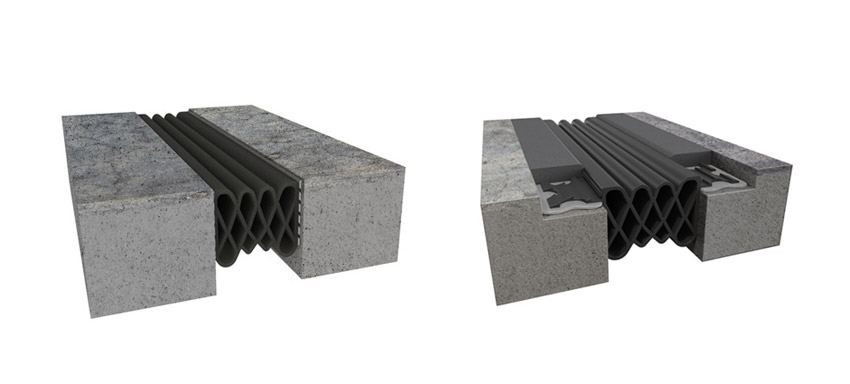
Compression seals come in different types and colors with very good capabilities to provide a watertight solution
for outdoor horizontal surfaces.
Choosing a manufacturer that utilizes Santoprene for the compression seal material as opposed to EPDM or Neoprene is highly suggested. Santoprene is a type of rubber compound that is widely used in the automotive industry due to its ability to resist abrasion, temperature extremes, and a wide range of chemicals. Its unique ability to allow for heat-welded seams and transitions ensures monolithic runs can be achieved without weak points for water to find. If a fire-rated compression seal is needed, mineral wool strips are often used that are held in place through compression. These are topped with fire caulk sealant to secure the barrier in place and protect it from water infiltration. Fire lab testing of compression systems is typically done for both concrete and drywall conditions.
Hybrid Compression Seal Systems
In locations where plazas and decks are part of the design, tied-in waterproofing is critical to avoid water infiltration into adjacent spaces. In response, manufacturers now offer a new hybrid design of compression seal system that is delivering a greater level of waterproofing in split-slab construction. The key benefit of this system is the use of an integrated counterflashing, which is engineered to channel water away from the joint opening. Of course, to be successful, it is vital that the counterflashing be compatible with the adjacent materials and adhesives being used. Failures in waterproofing can occur if the flashing fails to adhere or reacts to the adhesive. Where load factors require it, metal cover plates can be added over the top of the seal.

Hybrid compression seal systems bring the best of compressible seals plus the strength of metal frames
for split-slab construction.
Roof Bellows Systems
Expansion joints that pass along a roof membrane need particular attention to remain watertight. Such system use either a TPO or PVC membrane that is bowed up like a bellows so that it flexes to accommodate seismic or thermal movement. As with counterflashing, the seal must run under the metal flanges of the bellows system to allow water to be shed away from the joint opening. Also, a compatible, non-reacting mastic should be used to ensure watertight adhesion of the seal.
Beyond the typical horizontal aspect of a roof bellows expansion joint system, the transitions to walls, parapets, edges, or other building components is critical. Tying in horizontal and vertical joint systems requires transition covers to help maintain watertightness. Architectural drawings and details should always cover this, but the reality is that sometimes transition covers and tie-ins are missed. This can cause significant problems in the watertightness of the roof and adjacent areas.
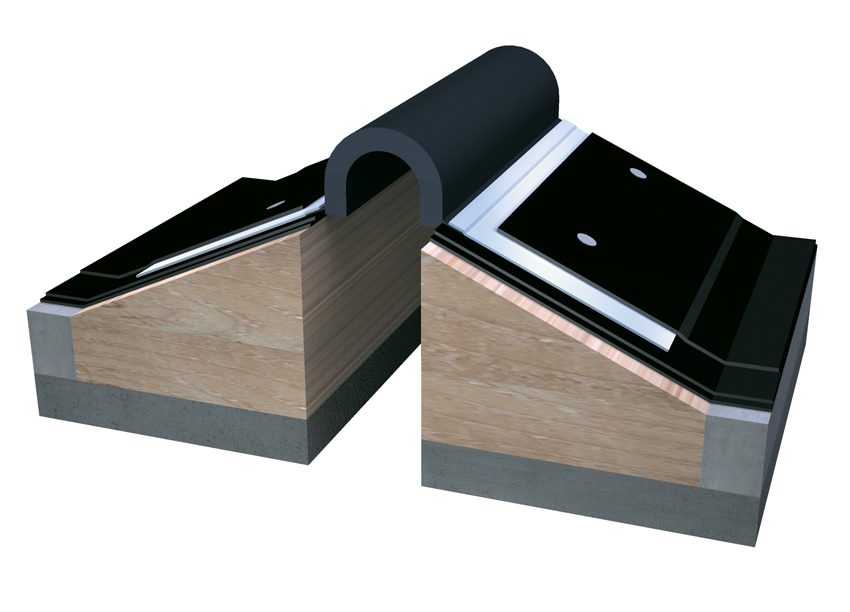
Roof bellows systems are made of flexible EPDM or TPO to cover and protect the expansion joint areas of roofing. Tying these systems into transitions at walls and other components is critical.
Metal Cover Plate Systems
In many cases, exposed foam or compressible seals will work just fine and provide suitable aesthetics for the particular area of the building in which they are installed. But often there are cases where a metal system is called for to achieve the strength and durability needed. Metal cover plate systems should always be used for joints 6 inches or wider in open structures. Wider joints have surfaces that are exposed to direct loads imposed by tires. A system with shallow, thick frames that are heavy duty offers a high degree of strength in its profile for longevity against the constant vibrations imposed on the cover plates each time a car or other vehicle travels over it. Other attributes to look for include noise dampening and water resistance.
There are two basic types of expansion joint cover solutions in general: surface or recessed mounts. Surface-mounted systems typically are very cost-effective but have wider metal sections that are visible. They are simple to install and great for remodels and additions or projects with particularly tight budgets. Products that are recessed into the deck are flush with the finished flooring and receive no jarring impacts from rolling loads. They also typically have far greater visual appeal since they can be specified with a recessed pan in the middle that can receive a finish material to match the adjacent materials (i.e., flooring, wall material, ceiling, etc.). In this way, the aesthetics of the space are not disrupted by looking at aluminum plates; however, they do require greater trade coordination and are more costly. Nonetheless, they may be the best choice, particularly for interior or exterior systems that are subjected to a lot of pedestrian or light vehicular traffic as noted earlier.
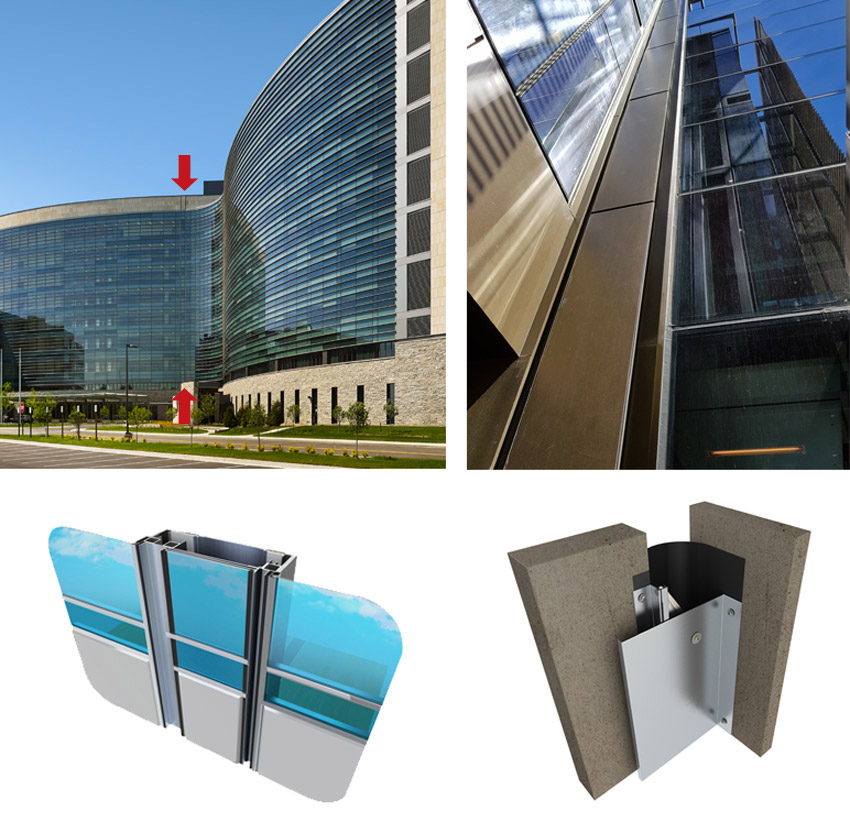
Metal cover systems can be selected that leave the metal exposed (right) or use an infill to match the adjacent surfaces (left).
Reinforced Vapor-Barrier Systems
One solution that can be used in certain applications is to employ a reinforced vapor barrier (RVB) to prevent water infiltration or channel water to drain locations via an integrated drain tube. The critical factor in installation of an RVB for waterproofing is to apply a bed of manufacturer-approved butyl sealant in the concrete block-out or along the frame along the entire length of the expansion joint. This will aid in securing the moisture barrier to the block-out and provide a watertight seal to prevent seepage around the block-out or frame. It is important to make certain that there is always enough drape left in the moisture barrier to ensure the system can fully open to its maximum distance without interference from the expansion cover components.
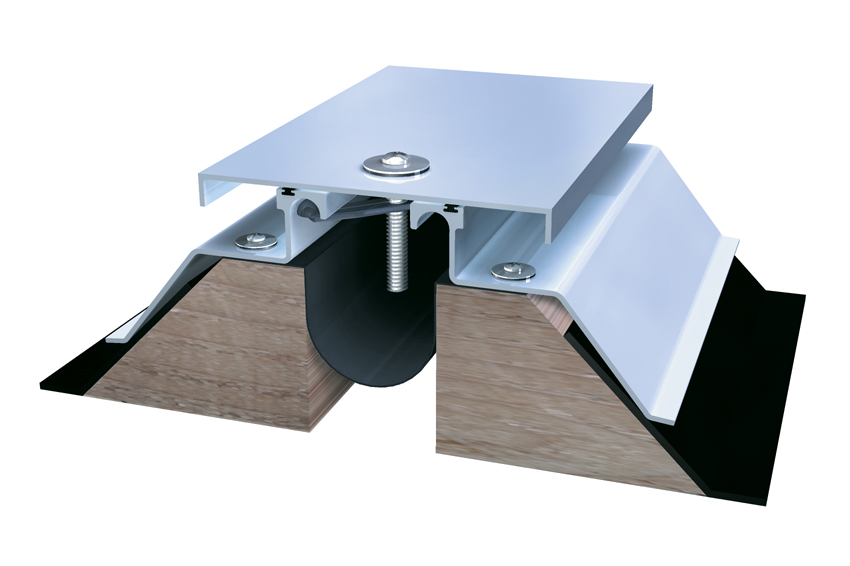
Reinforced vapor barriers can be added to expansion joint systems provided that they drape appropriately to still allow the proper movement of the expansion joint system.
Waterproof Fire-Resistive Joint Systems
We have commented on a few types of expansion joint systems that address fire resistance, such as compressible seals or fire-retardant foams. In addition, fire blankets are the most versatile system, suitable for expansion joint gaps of 2–32 inches and able to withstand high rates of movement. Fire blanket systems come in two forms: ceramic cloths with intumescent layering or graphite sheet goods encasing insulating blankets. In seismic conditions, they allow for approximately 50 percent of joint compression and expansion movement. Some models are able to retain their rating throughout lateral shear movement testing, while others cannot. Fire blankets are tested in concrete, but alternate substrate conditions may also be acceptable.
In all cases, the continuous, uninterrupted installation of the fire barrier is critical for life safety. This is especially true when using fire blankets since they need to be fully and carefully connected to the adjacent concrete surfaces and form a continuous barrier where vertical and horizontal conditions meet. At least one manufacturer has addressed this concern through the use of a modular system that allows separate sections to nest together, creating tight, continuous protection. Further, the edges of the blanket are pre-attached to metal flanges, assuring that the proper seal is obtained instead of relying on field installation to create an uncertain seal. These pre-attached flanges drastically reduce labor costs and ensure a uniform installation for a more reliably continuous seal.
Fire blankets can be specified either to withstand water or not. Those that cannot withstand water exposure and become wet are often rendered useless against smoke, fire, and heat, and even after redrying carry diminished fire resistance. Products that are rated and tested for water exposure during or after construction or for open structures, such as parking facilities and stadiums, provide fire protection even if they become wet. It is important then to select and specify the appropriate material for the water conditions anticipated in the building.
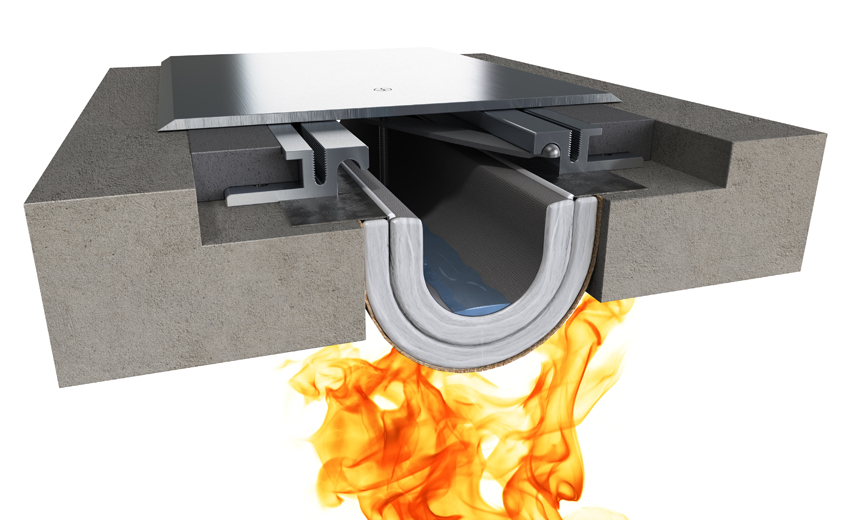
A common fire blanket type of expansion joint system can also be specified to withstand water, making it appropriate for use in a number of exterior settings.
In terms of moisture protection for fire blankets, sometimes a simple EPDM membrane is detailed to be draped and fixed over fire barriers for water-protection purposes. Unfortunately, this approach presents two significant issues. First, EPDM has a fairly low melting point compared to the requirements of fire-testing standards, which reaches 2000 degree Fahrenheit. In this case, the EPDM melts like napalm into the blanket layering, severely reducing its ceramic textile's effectiveness. If it is intended to be applied for temporary protection to keep blankets dry during construction, this is fine, but really is not acceptable for a permanent installation. Second, there are extremely few fire-blanket products on the market that allow for penetrations such as drains. Drains can be easily applied to EPDM, however they then need to be routed out and away above the blanket. Either a sloped waterproofing barrier or specifications of a product that has been tested by certified third-party agencies with a drain penetration should be used. Ideally, penetrations for drains should be avoided to the greatest extent possible.









